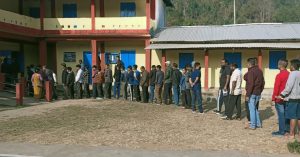The Bharatiya Janata Party (BJP) continues its winning streak in state assembly elections. It has returned to power in three states of India’s Northeast, forming governments either by securing an absolute majority or through alliances with regional allies.
Last month, three of the eight states in the country’s northeast – Tripura, Nagaland, and Meghalaya – went to the polls to elect state assemblies. The outcome was almost the same as in the previous assembly elections five years ago. Still, there were important takeaways, indicating the political trends in the frontier region.
Among the three states, the outcome in Tripura was unpredictable, owing to the Left-Congress pre-poll alliance and the emergence of a new party called the Tipra Motha led by royal scion Pradyot Kishore Manikya Debbarma. Yet the BJP managed to cross the halfway mark with 32 seats while its tribal ally, the Indigenous People’s Front of Tripura (IPFT), secured one seat out of the five it contested. In 2018, the BJP had secured 36 out of the 51 that it contested and IPFT eight out of nine in a house of 60 seats.
In Nagaland, the BJP’s alliance with the National Democratic Progressive Party (NDPP) reaped rich dividends, with the former securing victories in 12 seats with an increase in the vote share from 15.3 percent in the previous assembly elections to 19 percent. The NDPP won 25 constituencies out of 60 seats in the hill state, providing a comfortable majority for the alliance to form the government.
Unlike the other states, a weak opposition in Nagaland contributed hugely to the win of the NDPP-BJP coalition, even though the peace process with the rebel outfits, or Naga National Political Groups (NNPG), in the state has failed to yield a positive result after more than two decades of negotiations. An outcome of tremendous importance was the victory of two women legislators for the first time in the electoral history of the state.
Elections in Meghalaya delivered a fractured verdict and was along expected lines. The BJP failed to increase its tally from two in the previous polls but was successful in forming a post-poll alliance with Chief Minister Conrad Sangma’s National People’s Party (NPP), which emerged as the single largest party with 26 seats in a house of 60. The NPP formed a coalition government with the support of three more regional parties, similar to the coalition during its previous term.
The election results in the three states of India’s Northeast are as much an indication of the emerging political trends in the frontier region as they are about the health of the national parties in the country. The most striking aspect was the performance of the NPP, which belied the prognosis of most observers in the state. According to a party functionary, the secret lay in “meticulous planning” and an “effective campaign strategy” months ahead of the elections, in which Showtime Consulting made a crucial contribution. This apart, a divided opposition, which has been a hallmark of politics in Meghalaya, also played its part in ensuring the NPP’s success.
The Congress continues with its downhill journey in the Northeast, which is a stark reflection of the party’s floundering condition as well as the meager appeal of the Bharat Jodo Yatra (or Unite India March) that its leader, Rahul Gandhi, had embarked upon in September last year. In Meghalaya, the Congress party could win only five seats, which was a drastic reduction from its previous tally of 21 in the state. In Tripura, despite an alliance with the Left, Congress could not topple the BJP, indicating that the latter has entrenched itself deeply in the state.
The outcome in Tripura is a warning for the Left as well, as it was defeated for the second consecutive time by the BJP. Tripura was once a Left bastion but support here is eroding fast. The Tipra Motha’s entry added to the electoral competition, as the new party gobbled up a large chunk of the tribal votes. The party won 13 seats of the 42 it contested.
Nation-wide general elections are due in a little over a year from now. Assembly polls will be held in six more states of the country ahead of the general elections.
The eight states of the Northeast account for just 25 seats in the 543-seat lower house of India’s Parliament. Political and electoral trends in the Northeast do not reflect the mood in the rest of the country. Yet, the recent elections in Meghalaya, Tripura, and Nagaland provide some useful pointers.
First, the BJP has been able to consolidate the inroads it first made in the Northeast in 2018. However, it is facing some challenges in the expansion of its base in Meghalaya and also among the tribals in Tripura. Second, the results reveal the efficacy of the BJP’s electoral machinery, which facilitates framing appropriate strategies and stitching perfect alliances for forming governments.
Finally, the Congress’ Bharat Jodo Yatra had little impact on voters in the Northeast. While it may have created a stir in the states through which the march traversed, in the absence of a follow-up initiative or campaign in the Northeast, it failed to impress voters.

































